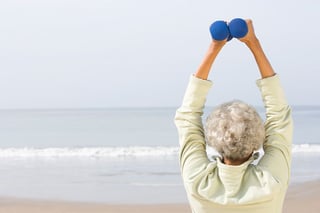 I have been asked several times over the years, “Why does it feel like my bones are breaking more easily?” The answer in most cases is low bone mass. There are several degrees of bone weakness and loss. These vary from mild to severe. Severe cases stem from disease processes such as osteopenia and osteoporosis which gradually develop over a period of years. The best way to assess your bone health is to have a bone density scan. This test should be done for anyone over 50 years of age. Osteoporosis is most prevalent in post menopausal women due to the drop in estrogen levels, but well over two million men suffer as well. Many people will accept this as part of the aging process, but much can be done.
I have been asked several times over the years, “Why does it feel like my bones are breaking more easily?” The answer in most cases is low bone mass. There are several degrees of bone weakness and loss. These vary from mild to severe. Severe cases stem from disease processes such as osteopenia and osteoporosis which gradually develop over a period of years. The best way to assess your bone health is to have a bone density scan. This test should be done for anyone over 50 years of age. Osteoporosis is most prevalent in post menopausal women due to the drop in estrogen levels, but well over two million men suffer as well. Many people will accept this as part of the aging process, but much can be done.
Exercise, proper nutrition, and supplementation have been shown to prevent, slow progression and even reverse bone loss. Calcium and Vitamin D are vital nutrients for bone health. Consume calcium rich foods and make sure to get enough Vitamin D, which ensures calcium is absorbed into the bones. Vitamin D can be acquired from getting 10 minutes a day of unprotected sun exposure, and from drinking fortified milk and juice products, or their supplements. Recent studies conclude Vitamin K may boost calcium absorption even further. There is no way to “feel” bone loss, so be sure to avoid salt, soda, and caffeine. These items are a bone’s worst enemy. Carbonated soda contains phosphoric acid which promotes calcium loss through urination. Caffeine and salt can actually leech calcium from the bones, making them weaker and more porous.
Weight bearing exercise and resistance training are critical contributions to bone density. Weight bearing exercise is any activity where the body is bearing its own weight, such as walking, jogging, aerobics, or dancing. Check out these latest weight-bearing workout trends. Resistance training is exercise that strengthens the muscles by working against a resistant force such as hand weights or selectorized machines. While both forms of resistance are beneficial, free weights like barbells and dumbbells involve a much larger degree of muscle recruitment. They are, therefore, the preferred choice in the prevention and management of osteoporosis. To achieve optimal results, resistance training needs to be performed with a moderate to vigorous amount of weight. With that in mind, these exercise programs should be done under direct supervision. Check out these resistance training exercises you can do at home. For individuals with established osteoporosis (existence of non-traumatic fracture or fractures), certain exercises are not advised. Be sure to consult a qualified exercise physiologist or personal trainer.
By following proper exercise and nutritional guidelines, you may save yourself from the results of a debilitating fracture or fall. Remember to see your physician before beginning any exercise program. Make no bones about it, your skeletal system will thank you.
For more senior fitness tips, subscribe to our blog.
